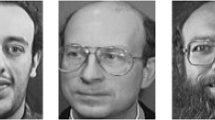Abstract
Most of the biometric techniques are conventional biometrics employing some neural network architecture consisting of suitable number of hidden layers in their training process. The recognition accuracy has no longer become a measure to ensure the method of recognition is robust. Robustness has also been attempted by using hybrid methods for training such as neuro-fuzzy method and applying some optimization technique. The traditional use of the learning concept has almost been saturated in the field of computer vision and face recognition. An emerging concept of learning method that is being researched internationally in several cognitive, computer vision and data classification tasks is deep learning, which is subfield of machine learning inspired by structure and function of artificial neural network. This paper suggests using deep learning in assessment of cognitive ability of human brain. We plan to train thousands of facial images into our image database. Deep learning was compared to shallow learning in face recognition task done for real time applications; cognitive ability assessment and inference for different age group and gender; study of reaction time, etc. A sample size of 380 persons was tested in real time deep learning based face recognition. Response time and correct identification were recorded that shows potent research scope of deep learning in assessment of cognitive ability of human brain at large scale. The cognitive ability of women was found more than that of women.

Similar content being viewed by others
References
Marzi T, Viggiano MP (2010) Deep and shallow encoding effects on face recognition: an ERP study. Int J Psychophysiol 78:239–250
Wong WK, Sun M (2011) Deep learning regularized fisher mappings. IEEE Trans Neural Netw 22(10):1668–1675
Gragnaniello D, Poggi G, Sansone C, Verdoliva L (2015) An investigation of local descriptors for biometric spoofing detection. IEEE Trans Inf Forensics Secur 10(04):849–863
Levi G, Hassner T (2015) Age and gender classification using convolution neural networks. http://www.google.co.in
El Khiyari H, Wechsler H (2016) Face recognition across time lapse using convolution neural networks. J Inf Secur 7:141–151
Wang X (2014) Deep learning in object recognition, detection and segmentation. Found Trends Signal Process 8(4):217–228
Haque A, Alahi A, Fei-Fei L (2016) Recurrent attention models for depth-based person identification. http://www.google.co.in
Rothe R, Timofte R, Van Gool L (2016) Deep expectation of real and apparent age from a single image without facial landmarks. http://www.google.co.in
Jain AK, Nandakumar K, Ross A (2016) 50 years of biometric research: accomplishments, challenges, and opportunities. Pattern Recognit Lett 79:80–105
Ordóñez FJ, Roggen D (2016) Deep convolutional and LSTM recurrent neural networks for multimodal wearable activity recognition. Sensors 16(115):1–25
Nathawani D, Sharma T (2016) Neuroscience meets deep learning. http://www.google.co.in
Spampinato C, Palazzo S, Kavasidis I, Giordano D, Shah M, Soulyk N (2016) Deep learning human mind for automated visual classification. http://www.googleco.in
Saxe AM (2013) Precis of deep linear neural networks: a theory of learning in the brain and mind. http://www.google.co.in
Poldrack Russell A, Farah Martha J (2015) Progress and challenges in probing the human brain. Nature 526(7573):371–379
Park SJ, Choi KH, P J, Kim JB (2016) A study on spatial analysis using R-based deep learning. Int J Softw Eng Appl 10(05):87–94
Makeig S, Kothe C, Mullen T, Bigdely-Shamlo N, Zhang Z, Kreutz-Delgado K (2012) Evolving signal processing for brain–computer interfaces. In: Proceedings of IEEE, vol 100, pp 1567–1584
Understanding the Brain (2007) The birth of a learning science. Centre for Educational Research and Innovation, Organisation for Economic Cooperation and Development, © OECD 2007
Alpaydın E (2014) Introduction to machine learning, 2nd edn. The MIT Press, Cambridge
Fu S, He H, Hou ZG (2014) Learning race from face: a survey. IEEE Trans Pattern Anal Mach Intell 36(12):2483–2509
Sinha GR, Patil SB (2013) Biometrics: concepts and applications. Wiley India (subsidiary of John Wiley), New York
Goswami G, Bhardwaj R, Singh R, Vatsa M (2011) MDLFace: memorability augmented deep learning for video face recognition. http://www.google.co.in
Kasar MM, Bhattacharyya D, Kim TH (2016) Face recognition using neural network: a review. Int J Secur Appl 10(03):81–100
Pinaki Roy Chowdhury (2016) Machines (non-human) and thinking: can they coexist? Curr Sci 110(776):776–781
Ramadas J, Chunawala S (2004) Review talks delivered at epiSTEME-1. In: International conference to review research on science, technology and mathematics education. International Centre, Goa, Homi Bhabha Centre for Science Education, Tata Institute of Fundamental Research, December 13–17
Munivenkatappa A, Bhagvatula ID, Shukla D, Upadhyay N, Rao SL, Subbakrishna DK, Rajeswaran J, Thomos RD (2013) Brain morphometric changes and cognitive domain correlations in early mid to moderate traumatic brain injury. Ind J Neurotrauma 10:80–85
Ramabrahmam V (2005) Human cognitive process-an ancient Indian model. In: International vedic conference on “contributions of vedas to the world, Haridwar, India, January 27–30
Kant Chander (2015) A multimodal approach to improve the performance of biometric system. BIJIT BVICAM’s Int J Inf Technol 7(2):891–895
Agrawal P, Rizvi SAM (2014) Pattern matching based technique to solve motif finding problem. BIJIT BVICAM’s Int J Inf Technol 1(1):17–21
Author information
Authors and Affiliations
Corresponding author
Electronic supplementary material
Below is the link to the electronic supplementary material.
Rights and permissions
About this article
Cite this article
Sinha, G.R. Study of assessment of cognitive ability of human brain using deep learning. Int. j. inf. tecnol. 9, 321–326 (2017). https://doi.org/10.1007/s41870-017-0025-8
Received:
Accepted:
Published:
Issue Date:
DOI: https://doi.org/10.1007/s41870-017-0025-8




